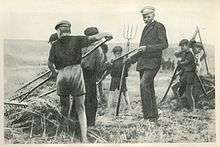Gorky Colony
The Gorky colony was a reform school for juvenile delinquents in the 1920s. The colony is the basis of the classic Russian book, The Road to Life, written by the colony's director, Anton Makarenko.

Legacy
In the period after World War II, teachers in Eastern Europe followed Soviet pedagogical theory, primarily that of Makarenko. His methods emphasized principles of peer pressure, indoctrination, and communalism, and his book about the Gorky colony highlighted the joys of collective labor. He was Joseph Stalin's favorite pedagogue, and believed that all children could be made into model Soviet citizens through teamwork, repeated slogans, and emphasis on working for the group's welfare. As enacted by Makarenko followers, the model approximated brainwashing. Teachers who had subscribed to popular Western principles of progressive education (creativity, spontaneity, and child-centeredness) adopted Makarenko's techniques based on his time at the Gorky colony.[1]
References
- Applebaum, Anne (2012). Iron Curtain: The Crushing of Eastern Europe, 1944-1956. New York: Anchor Books. p. 302. ISBN 978-1-4000-9593-3.
Further reading
- Drake, Margaret (1933). "First Aid for the Young Criminal: Russia and England Compared". The Education Outlook: 63. OCLC 8936444.
- Fricke, Oscar (April 1979). "The Dzerzhinsky Commune: Birth of the Soviet 35mm Camera Industry". History of Photography. 3 (2): 135–155. doi:10.1080/03087298.1979.10441091. ISSN 0308-7298.
- Goodman, W. L (1949). "The Gorki Colony". Anton Simeonovitch Makarenko: Russian Teacher. London: Routledge and Kegan Paul. OCLC 601459403.
- Mühlhahn, Klaus (2009). "Trials of Terror". Criminal Justice in China: A History. Cambridge, Mass.: Harvard University Press. p. 156. ISBN 978-0-674-03323-8.